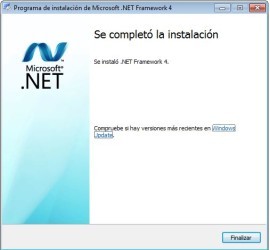What makes Microsoft .NET Framework 4 Client Profile essential for your system?
The Microsoft .NET Framework 4 Client Profile stands as a crucial update for older Windows systems, ensuring they can run modern applications with smooth compatibility. It includes improvements in the Common Language Runtime (CLR) and Base Class Library, vital components that serve as the backbone for running any .NET programs. This version optimizes the way assemblies are loaded, which enhances application startup times and reduces system resource usage.
Detailed feature specifics highlight the enhanced security and bug fixes in this iteration. The web installer ensures that security protocols are up-to-date, preventing vulnerabilities in critical applications that could lead to system compromise. Additionally, memory usage has been optimized, and garbage collection is more effective, leading to a more responsive system.
How the Base Class Library improvements enhance application development
Developers will notice a significant increase in their productivity, thanks to the Base Class Library updates. New additions to the library provide a wider range of features, effectively reducing the amount of custom code they need to write. This means more focus on the unique value of their applications and less on reinventing the wheel.
The enhancements made to fundamental classes streamline interactions with the operating system, file system, and network, presenting a much more consistent programming model for developers to utilise. Furthermore, the Class Library now supports additional cultures, offering a global perspective for applications.
Understanding the Common Language Runtime updates
Updates to the CLR are significant, as they improve both the reliability and performance of applications. With the newer version, there’s improved support for parallel computing, meaning applications can better take advantage of multi-core processors for increased efficiency and responsiveness.
Moreover, the CLR now includes a feature called ‘background garbage collection’. This helps to minimize disruptions caused by memory management tasks without sacrificing application throughput, which is an essential feature for long-running and resource-intensive software.
Discover the main features of the .NET Framework 4 Client Profile
The .NET Framework 4 Client Profile equips users with a diverse set of capabilities that support a wide variety of applications. One of the standout features is the managed extensibility framework, which allows for easy componentisation and the reuse of code. This means developers can create modular applications with components that can be easily replaced or updated.
Another significant feature is the improvement of Windows Presentation Foundation (WPF) in terms of graphics performance. The rendering engine has been refined to provide a more fluid and rich user interface experience, with better support for advanced typography and graphics hardware acceleration.
Managed Extensibility Framework and its benefits
This feature promotes a plug-and-play model for developers to extend their applications dynamically. The Managed Extensibility Framework greatly reduces the complexity in finding, loading, and managing the extensions. It serves as a boon for complex software ecosystems, allowing seamless integration and updates.
Flexibility and adaptability are the pillars of this framework. It encourages a more collaborative and agile development approach, aligning with modern software demands. Such capabilities are essential when catering to the ever-changing landscape of user requirements and technology evolution.
Enhancing the User Interface with WPF improvements
User experience is paramount, and the enhancements to WPF reflect this prioritization. Applications built on the .NET Framework 4 Client Profile enjoy a more immersive and responsive UI, thanks to direct support for multitouch functionality and an improved graphics subsystem.
Developers find that advanced UI features are now more accessible. Creating visually stunning and intuitive applications becomes less about overcoming technical hurdles and more about creativity and design. This aspect is sure to benefit end-users who value engagement and aesthetic as much as functionality.
How to download Microsoft .NET Framework 4 Client Profile
Installing the .NET Framework 4 Client Profile is straightforward. The first step is to navigate to PortalProgramas and locate the download link at the top of the page. This ensures you’re accessing the most recent version of the installer. Then, simply click on the link to begin the web installation process, which will manage the download and installation with minimal user intervention.
The web installer is designed to be a lightweight tool that automatically downloads only the necessary components for your system. This translates to a faster installation time and a no-hassle approach for users who may not have extensive technical knowledge or fast internet connections.


